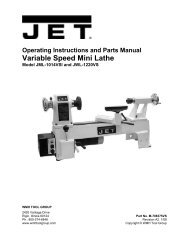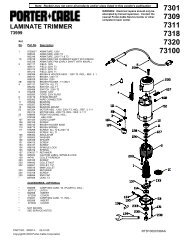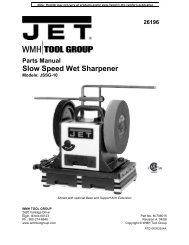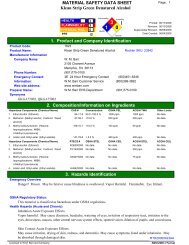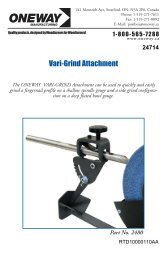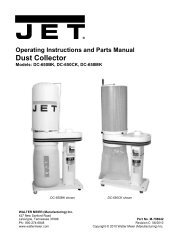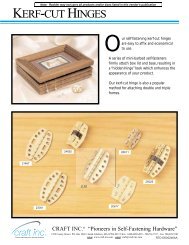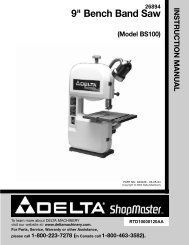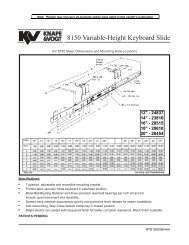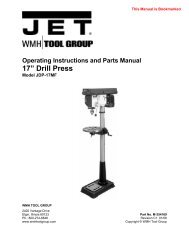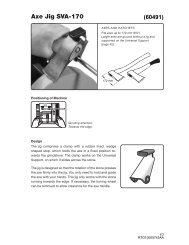Titebond Liquid Hide Glue - Rockler.com
Titebond Liquid Hide Glue - Rockler.com
Titebond Liquid Hide Glue - Rockler.com
You also want an ePaper? Increase the reach of your titles
YUMPU automatically turns print PDFs into web optimized ePapers that Google loves.
Franklin International<br />
MATERIAL SAFETY DATA SHEET<br />
MSDS Name: <strong>Titebond</strong> <strong>Liquid</strong> <strong>Hide</strong> <strong>Glue</strong><br />
MSDS Number: 5014<br />
Revision Date: 6/14/04<br />
<strong>Rockler</strong> SKUs: 33763, 50252, 50260<br />
SECTION 1 - CHEMICAL PRODUCT AND COMPANY IDENTIFICATION<br />
Product Name:<br />
<strong>Titebond</strong> <strong>Liquid</strong> <strong>Hide</strong> <strong>Glue</strong><br />
CAS Number:<br />
none<br />
HMIS Hazard Rating: Health: 1 Fire: 1 Reactivity: 0<br />
Company Identification:<br />
Franklin International<br />
2020 Bruck Street<br />
Columbus OH 43207<br />
Contact:<br />
Franklin Technical Services<br />
Telephone/Fax: (800) 877-4583 (614) 445-1493<br />
Emergency Phone (24 Hour): Franklin Security<br />
(614) 445-1300<br />
Chemtrec (24 Hour): (800) 424-9300<br />
Chemtrec International: (703) 527-3887<br />
Product Class<br />
Protein dispersion<br />
Product Use:<br />
wood glue<br />
Product Code: 1103<br />
Division:<br />
Construction Adhesives & Sealants<br />
SECTION 2 - COMPOSITION AND INFORMATION ON INGREDIENTS<br />
Hazardous Ingredients CAS Number Percent<br />
ammonium thiocyanate 1762-95-4 8.30<br />
dicyandiamide 461-58-5 3.70<br />
OSHA PELs & ACGIH TLVs are listed in Section 8 where applicable.<br />
SECTION 3 - HAZARD IDENTIFICATION<br />
EMERGENCY OVERVIEW:<br />
An amber colored liquid with little odor. Slippery in the wet state.<br />
ROUTES OF ENTRY:<br />
Inhalation: yes<br />
Ingestion: yes<br />
Skin:<br />
no<br />
Eye:<br />
yes<br />
INHALATION:<br />
May be irritating to upper respiratory tract.<br />
INGESTION:<br />
Single dose oral toxicity is considered to be extremely low. No<br />
hazards expected from swallowing small amounts incidental to normal<br />
handling operations. Ingestion may cause gastrointestinal irritation.<br />
SKIN:<br />
Prolonged or repeated skin contact can cause irritation.<br />
EYE:<br />
RTD20000024AA
Mildly irritating to eyes.<br />
MEDICAL CONDITIONS AGGRAVATED BY EXPOSURE:<br />
None expected in normal use.<br />
CARCINOGENICITY:<br />
IARC: No<br />
NTP: No<br />
OSHA: No<br />
REPRODUCTIVE TOXICITY:<br />
None anticipated based on product formula.<br />
TARGET ORGANS:<br />
Target organs: eyes, skin, and respiratory system.<br />
SECTION 4 - FIRST AID MEASURES<br />
INHALATION:<br />
Remove to fresh air. If difficulty persists, seek medical attention.<br />
INGESTION:<br />
If swallowed, call poison control center immediately. Follow their<br />
specific instructions. Do not induce vomiting.<br />
SKIN:<br />
Wash with soap and water. Contact a physician if irritation develops<br />
or persists.<br />
EYE:<br />
Hold eyelids apart and flush with plenty of water for at least 15<br />
minutes. Seek medical attention.<br />
SECTION 5 - FIRE-FIGHTING MEASURES<br />
Flammability Class (OSHA) IIIB<br />
Flash Point:<br />
> 200 F<br />
Setaflash<br />
Explosive Range:<br />
Not applicable<br />
EXTINGUISHING MEDIA:<br />
Use alcohol foam, carbon dioxide, water spray, or ABC dry chemical<br />
when fighting fires involving this product.<br />
HAZARDOUS COMBUSTION PRODUCTS:<br />
Not applicable (water based product). However, solid material will<br />
support <strong>com</strong>bustion if water has evaporated.<br />
SECTION 6 - ACCIDENTAL RELEASE MEASURES<br />
CONTAINMENT TECHNIQUES:<br />
Use inert absorbent to dike the spill. Keep away from drains.<br />
CLEAN-UP:<br />
If possible pump liquid into an approved container or spread absorbent<br />
over spill and shovel product/absorbent mixture into an approved<br />
container. If product has dried scrape up and place in an approved<br />
container.<br />
EMERGENCY MEASURES:<br />
None required.<br />
SECTION 7 - HANDLING AND STORAGE<br />
HANDLING:<br />
Wash hands before eating.<br />
STORAGE:<br />
Keep from freezing. Best when stored above 40 F (4 C).<br />
SECTION 8 - EXPOSURE CONTROLS AND PERSONAL PROTECTION
Occupational Exposure Limits<br />
ACGIH TLV ACGIH TLV-C ACGIH STEL OSHA STEL OSHA PEL<br />
ammonium thiocyanate<br />
N/est N/est N/est N/est N/est<br />
dicyandiamide<br />
N/est N/est N/est N/est N/est<br />
ENGINEERING CONTROLS:<br />
Natural ventilation should be adequate under normal conditions.<br />
Maintain standard plant ventilation.<br />
OTHER:<br />
Facilities storing or utilizing any chemical should be equipped with<br />
an eyewash facility and a safety shower.<br />
RESPIRATORY PROTECTION:<br />
Respiratory protection is not expected to be necessary under normal<br />
use. Follow requirements for respiratory protection in OSHA 1910.134.<br />
EYE PROTECTION:<br />
Chemical splash goggles (ANSI Z87.1 or approved equivalent).<br />
SKIN PROTECTION:<br />
Where skin contact can occur, wear impervious gloves.<br />
SECTION 9 - PHYSICAL AND CHEMICAL PROPERTIES<br />
Form:<br />
<strong>Liquid</strong><br />
Appearance/Color:<br />
Amber<br />
Odor:<br />
Slight<br />
Solubility (in water): Complete<br />
pH Value: 6.5<br />
Boiling Range/Point:<br />
212.øF<br />
Evaporation Rate:<br />
Slower than n-Butyl Acetate<br />
% Volatile: 48.%<br />
Specific Gravity: 1.15<br />
VOC: 0<br />
SECTION 10 - STABILITY AND REACTIVITY<br />
Stability:<br />
This product is stable<br />
Hazardous Polymerization: Hazardous polymerization will not occur<br />
CONDITIONS TO AVOID:<br />
High temperatures promote hydrolysis.<br />
INCOMPATIBLITY:<br />
Strong acids and strong bases<br />
SECTION 11 - TOXICOLOGICAL INFORMATION<br />
Acute and chronic health effects are not expected as long as good<br />
industrial hygeine and safety precautions are followed.<br />
SECTION 12 - ECOLOGICAL INFORMATION<br />
This formulation has not been tested for environmental effects.<br />
SECTION 13 - DISPOSAL CONSIDERATIONS<br />
WASTE DISPOSAL:<br />
Disposal of this product must <strong>com</strong>ply with all applicable federal,<br />
state and local regulations.
CONTAINER DISPOSAL:<br />
Disposal of this container should <strong>com</strong>ply with all applicable federal,<br />
state and local regulations.<br />
SECTION 14 - TRANSPORT INFORMATION<br />
UN Number<br />
none<br />
UN Pack Group<br />
N/A<br />
UN Class<br />
Nonhaz<br />
ICAO/IATA Class<br />
Nonhazardous<br />
IMDG Class<br />
Nonhazardous<br />
Shipping Name<br />
Nonhazardous<br />
Packaging may not be approved for shipping by air. Please contact<br />
Franklin International for further information.<br />
SECTION 15 - REGULATORY INFORMATION<br />
TSCA (Toxic Substances Control Act Inventory):<br />
All <strong>com</strong>ponents of this product are listed on the TSCA inventory except<br />
as exempted.<br />
PENNSYLVANIA:<br />
Hazardous <strong>com</strong>ponents required to be listed at 1% or more:<br />
ammonium thiocyanate; thiocyanic acid, ammonium salt; 1762-95-4<br />
Non-hazardous <strong>com</strong>ponents required to be listed at 3% or more:<br />
dicyandiamide 461-58-5; hide glue 9007-34-5; water 7732-18-5<br />
NEW JERSEY:<br />
powdered hide glue 9007-34-5; water 7732-18-5; ammonium thiocyanate<br />
1762-95-4; dicyandiamide 461-58-5; polyalkene glycol 9038-95-3<br />
SECTION 16 - OTHER INFORMATION<br />
DISCLAIMER:<br />
While the information and re<strong>com</strong>mendations set forth herein are<br />
believed to be accurate as of the data hereof, Franklin International<br />
makes no warranty, express or implied, with respect thereto and<br />
disclaims all liability from reliance thereon.



